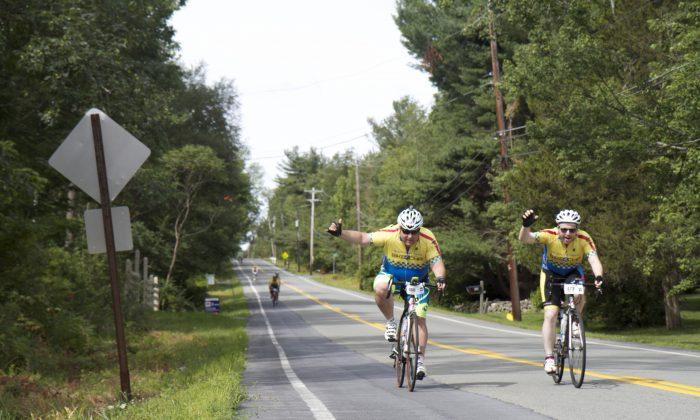PORT JERVIS—It was one of those perfect summer evenings, when the breeze mingles with the scents of warmed flowers and grass, and the sun is angled low painting the sides of buildings with a soft glow. The historic Erie Hotel and Restaurant in Port Jervis was an inviting old girl, welcoming travelers of the Historic Tavern Trail of Orange County for a casual discussion on local history.
The hotel was bustling at 5:30 p.m. on Friday, July 31, with the antique bar crowded with end of day drinkers and chatting faces, while restaurant tables were quickly filling up. The Erie Hotel was built in 1880, when Port Jervis was a railway and industrial hub.
Passion and love for these fascinating old towns in Orange County is undeniable when listening to the historians and locals share stories. But is that love enough to breathe life back into the towns that saw their heydays during the railway era of the late 19th century and early 20th century?
“Port Jervis in many ways, is only a ghostly image of the city it was from about 1880 to 1925. During that time the village blossomed as a canal, railroad and industrial center, so much so that it became a city in 1907,” according to the Minisink Historical Society.
But strolling through downtown Port Jervis on Friday evening at dusk revealed a different picture than a ghost town. The town has beautiful bone structure, as during it’s development years, much investment was put into architectural excellence. It’s Victorian and Gilded Era charm is simply glowing, and there is an air of possibility, perhaps somewhat similar to how the settlers felt and the railway men felt when they decided this is a place they can pour their energy into making it thrive.
The location is still undeniably favorable, considering it is only around two hours by Metro North train from New York City, and similar driving distance. It’s on the border of the states of Pennsylvania and New Jersey, and encompasses stunning country-side, rivers, and mountain ranges. It is close to the Catskills Mountain range and to the fine towns established along the banks of the Hudson River.
The D&H Canal changed American geography. The 108-mile, 108-lock water way operated from 1828-1898 flowing right through Deerpark, where there is a beautiful little canal museum on the river and guided trails. The D&H canal was vital for fueling the Hudson Valley brick industry which supplied New York’s building needs, and bringing coal from Pennsylvania mines via the Hudson River downriver to New York City.
People like Norma Schadt, who has been Deerpark’s historian for the past 20 years, have kept the story alive. Her love of the area spurred her on to write a book, “Deerpark” and reopen the Town of Deerpark 1863 School House Museum.
“In 1995 she cut the chains,” said Lynn Burn, the newly appointed Deerpark historian. Schadt gave her the reins last year.
Schadt spoke to the group at the Erie Hotel, highlighting the most important historical moments for Deerpark and Port Jervis.
- This year Deerpark celebrates the 325th anniversary of the first settler back in 1690 who was a blacksmith
- The D&H Canal changed history by boosting industrial development
- Mohawk Indians attacked
- A significant Revolutionary battle, the Battle of Minisink was fought
- The railroad came in the late 19th century, and Port Jervis became a major industrial town
Who Cares?
There’s a gap growing between how local history is presented, or marketed, to the public and how younger generations, such as millennials and Gen Y'ers like to receive their information. It leads to the misunderstanding that “young people” aren’t interested in local history. But that’s not the case according to Johanna Yaun, Orange County’s official historian.
Yaun is intelligent and incredibly enthusiastic about history, and has the advantage of growing up in the digital age to help her bridge the gap. She is assured that the youth and the young adult population are very interested in history.
“The whole way people used to be involved in local historical societies is dying, no young people sign up for membership any more...so we need to keep up with the contemporary world,” Yaun said, “So how do we stay alive right now, based on current trends?”
Yaun proves the thriving love of history with examples of popular culture. “‘Hamilton’ is one of the number one Broadway shows right now,” she pointed out. The new show is based strictly on Alexander Hamilton’s political life, an unlikely story line to be popular with a younger audience, but it’s packaged in a modern way.
“Then there’s ‘Turn: Washington’s Spies,’ a Revolutionary War spy drama in which younger audiences are watching,” Yaun said. AMC just announced a third season on AMC due to the incredible popularity, younger audiences included.
“There’s Downton Abbey, the most watched show on PBS,” continued Yaun. That show is another period drama that beat records for viewership, with younger audiences just as hooked as any. “This stuff is cool right now, so my point is we have to capitalize on that.”
It matters that the history doesn’t lose relevance to younger generations in Deerpark. History appreciation is an important part of cherishing a community, as well as showing our long-standing strengths and future possibilities. It’s learning about the people that lived here in years gone by and what their day to day life was like that really captures people’s attention.
That is why the historic drama T.V. shows are so loved, and why the re-enactment programs are so engaging, such as the colonial cooking demonstrations at Minsink’s Fort Decker Museum of History. The museum is a bit of a treasure in the area. As well as watching how traditional 18th century food, such as breads, game, and soups were prepared, it has an heirloom seed garden, replanted each year using the traditional methods of the early settlers.
The fact is, as Yaun pointed out, that the “herb garden and tea afternoon” is becoming more popular and old fashioned living in general are “right on trend.” There is a shift back to more wholesome living due to fears about pesticides and GMO foods. So Yaun’s thinking is on how to bring these two worlds together.
People these days have come to rely on smart phones and internet as sources of information. So, as an advocate for all the small museums and historical societies in the area, Yaun wants to help market these gems to people in new ways, like Historical Trail apps, and more online guides and marketing resources and events for tourists traveling through.
There is another important factor Yaun has to consider, “the fact is we’re not going to survive without the revenue coming in from the larger audience.”
The older generation of historians and history lovers have done incredible work preserving history, writing stories, hosting events, and gathering support for the valuable history of the area, but understandably struggle to keep up with how to appeal to newer generations, and bring in new enthusiasts and revenue. That’s where Yaun would like to help most.
About the Historic Tavern Trail
The Historic Tavern Trail that held the event at the Erie Hotel is an experiment, an alternative to the wine trails, that gets people together to share stories and passion for local heritage.
The Historic Tavern Trail of Orange County meets at the area’s oldest taverns and inns on the last Friday of every month, April through October, from 5:30 p.m.-7 p.m.
Aug 28—Schlesinger’s Steakhouse, New Windsor
Sep 25—Chateau Hathorn, Warwick
Oct 30—Ward’s Bridge Inn, Montgomery



Friends Read Free